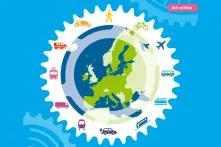Every passenger aims to get from point A to B as quickly, easily and affordably as possible. For persons with reduced mobility, one cannot talk of fair and equal access: the access to the means of transport requires a pre-booking a long time ahead and changing vehicles is a complex procedure. Furthermore, many vehicles cannot be entered without the assistance of staff members — which itself is a violation of the meaning of accessibility as stated in the United Nations Convention on the Rights of Persons with Disabilities (UNCRPD).

Even worse, the assistance is available only within limited opening hours. Additionally, many vehicles and stations lack information and signage for blind persons and information in simple language is also scarce. The city of Vienna stands out in this regard. The public transport provider “Wiener Linien” has developed a comprehensive approach to inclusive mobility, including guidance for blind or deaf people and a dynamic information system about the departure times of “low floor” streetcars.
European mobility can only be sustainable if public transport is accessible for everybody. Otherwise, users will always revert to the solution of motorised private transport. Consequently, the freedom of mobility is strongly related to the question of accessibility to the different means of transport for everybody.
Accessibility is, from a wider perspective, a question about how open different means of transport are for different parts of the society, as the needs of the individual user differ widely.
To give an example, it is not only about how many places for wheelchairs are made available on trains, but whether these must be reserved in advance (and by which deadline), whether the stations and trains are accessible (with or without assistance), and at which times the assistance is available.
Within the framework of the European Disability Strategy 2021-2030 (EDS) and the European Accessibility Act, the EU has set up goals for the mobility of people with special needs, with the latter broadening the scope of accessibility to private services. By 2025, when the act is to be fully implemented by EU Member States, ticket machines will have to be accessible for everybody without any external help. The problem though is that only the ticket machines will have to be accessible, as the regulation does not cover their environment.
The Technical Specification for Interoperability for Persons with reduced mobility (TSI PRM) applies to heavy rail across Europe. Within the TSI PRM, rules are set up for the design of stations and rolling stock to provide level access for passengers, tactile and visual guidance, obstacle free routes and parking, and ramps with handrails and/or elevators or alternative accessible routes in case of their disfunction, as well as the provision of accessible toilets and nappy-changing facilities. For new rolling stock, specific rules have been agreed regarding seating and general design, as well as boarding platforms.
One general problem is still the wide variation of the height of platforms across Europe. While the general height for new platforms is set to 550 mm in the TSI Infrastructure, the currently existing range is from 200 mm to 1150 mm, which makes it impossible to provide adapted rolling stock and, consequently, easy access for all routes and stations.
EU passenger rights regulations not only define the rights for help and reimbursement for delayed or cancelled flights, trains and buses, but also set the framework concerning under which conditions help must be provided to persons with reduced mobility.
During the recent renegotiation of the EU Passengers’ Rights directive, there has been an intense debate about which deadlines will be set for requesting services regarding the boarding of trains. The range varies from 0 to 48 hours, depending on the size of the station. Railway companies and the respective Member States have previously argued for a longer notification span (to save money), while consumer interest groups argue for a shorter one.
The Netherlands set an example with just 0 to 1 hours of pre-notification at all stations, which makes it very easy for persons with reduced mobility to travel spontaneously.
In principle, a person with reduced mobility has the same right to access air, train, bus, coach or boat travel as anybody else. Yet the relevant legislation states: “You cannot be refused transport because of your disability or reduced mobility except for reasons justified on the grounds of safety or of the design of the vehicle or infrastructure.” The aspect of design is a tricky one, because although regulations such as the TSI-PRM set out an accessible design for the future, nowadays, persons with reduced mobility can relatively easily be denied boarding for “safety or design reasons”.
With the “Access City Award”, the EU tries to direct attention to cities that have made special efforts regarding the accessibility of public spaces and services such as public transport for citizens with special needs. Projects like “Cycling Without Age” provide inclusion in this way by offering free bike rides to the local nursing home residents on a trishaw.
While serious efforts are being made at the EU level, it is still upon the Member States to assure a thorough implementation. Investments in accessible means of transport are long-term projects, since trains, planes, buses and so on usually have long lifespans, as does their respective infrastructure. This makes a common European approach even more important, in order not to revive national borders for persons with reduced mobility. But barrier-free modes of transport also increase the attractiveness for all users. Low-floor rolling stock not only makes boarding easy for wheelchairs, but does so equally for strollers, older people, parents with little children and those with a heavy suitcase or big shopping bags. With 100 per cent accessibility of their light-rail stops (since 2016) and rolling stock (since 2016), the “Stuttgarter Straßenbahnen AG” proves that accessibility is not in the realm of fantasy. On the contrary, involving people with reduced mobility in legislation, the planning of stops/stations and the testing of new vehicles is all that it takes.



